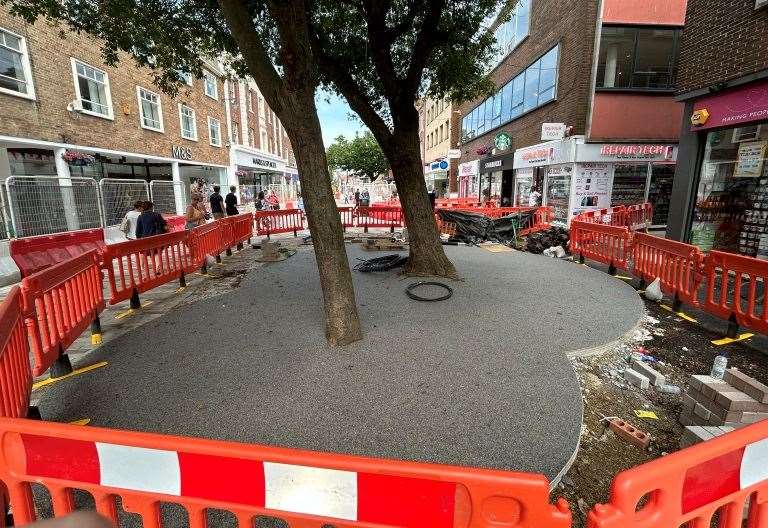Use of Flexipave eco-material around base of trees in St George’s Street, Canterbury, divides opinion

Shoppers are divided over the appearance of a new eco-material laid in a Kent high street to hide the roots of towering trees.
Flexipave – which is made from recycled rubber tyres and stone aggregate – has been put down in St George’s Street, Canterbury, as part of a £1 million regeneration project.
The substance is crack-resistant and porous, so tree roots buried beneath can move freely without disturbing the surface, and still have access to a healthy supply of water.
But the use of the material has split opinion, with some people branding it “ridiculous”, and others applauding the sustainable approach of Canterbury City Council, which has already been criticised for using colourful paving stones elsewhere the high street.
The latest debate kicked off this week, when a picture of a tree with Flexipave at its base was shared on the Canterbury Residents Group Facebook page.
mpu1
Robert Thacker-Goddard described the appearance as “vile”, adding: “It has ruined the historic look of our loved town.”
Meanwhile, Colette Baumback branded the look “awful”, and expressed concern for the longevity of the clean-cut surface.
“It can’t be good for the trees and it’s going to crack – what a mess the high street is,” she wrote.
But when KentOnline went out onto the streets of Canterbury, people were largely supportive of the use of the material.
Hayley Chandler, from Ash, says tree roots that previously poked through the pavement were a safety hazard.
“I think it is better for people with mobility aids, such as walking sticks, walkers and wheelchairs, as it’s less dangerous,” the 26-year-old added.
“It is also better for pushchairs, as where the paving had sunk before, when it rained you couldn’t judge if there was a hole there, which made it a health and safety risk.
mpu2
“I think it’s important to preserve trees because in a city you need trees due to the pollution.
“I do understand the view that it’s a historic city and it isn’t in keeping with that, but we need to preserve nature.”
Callum Donnelly, from Canterbury, commended the city council for using an economically friendly surface.
“We are a historic city and very good at looking after those parts, but we have to move with the times,” he said.
“Having modern areas like here and Whitefriars is great and it is important we mesh those together.
“If it is of benefit for the trees and ambience then great. I love it.”
The high street makeover began five months ago and is due to be completed in approximately three weeks.
Only last month the city council came under fire for the design of new paving laid as part of the controversial project.
Many described the colourful stones as “out-of-keeping” with the city’s historic setting, with one commenter claiming it make Canterbury “look like Essex”.
But Trevor Davis, who lives in the city, this week described the whole project – including the Flexipave – as a “big improvement”.
“I like the colours, the tiles and the finish around the trees,” the 73-year-old told our reporter.
“The trees have always been a feature of the market area in Canterbury and are encouraged to thrive.
“Canterbury is old but it is modernising every day. I think it is 100% in keeping with the features of the city.”
City council spokesman Rob Davies says Flexipave is a relatively new material and increasingly used around trees in urban environments.
“Because the material is able to flex, tree roots are given room to grow without breaking the pavement surface,” he said.
“It also allows oxygen and water through to the tree roots, reducing their need to put out moisture-seeking roots.
“The material also plays a role in sustainable drainage systems (SUDS) as it allows sudden downpours of rain to drain away quickly, unlike the impermeable tarmac and concrete.”
When defending the high street scheme previously, Mr Davies argued: “It should also be remembered that this part of St George’s Street was destroyed during the war so the architecture is modern and therefore using modern rather than natural stone materials in this part of the city is more appropriate.
“We are sure that once the whole project is complete and the area is back in full public use, the predominant opinion will be that we’ve done a great job on it.”













